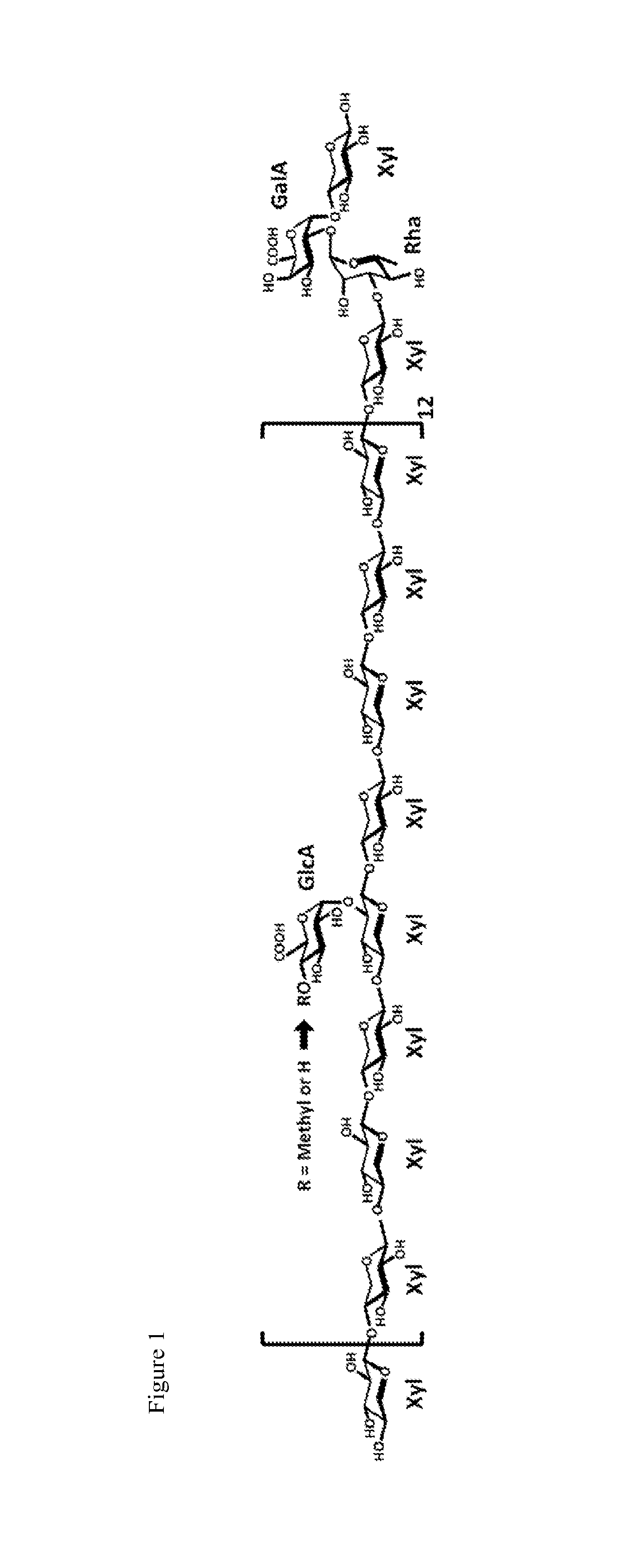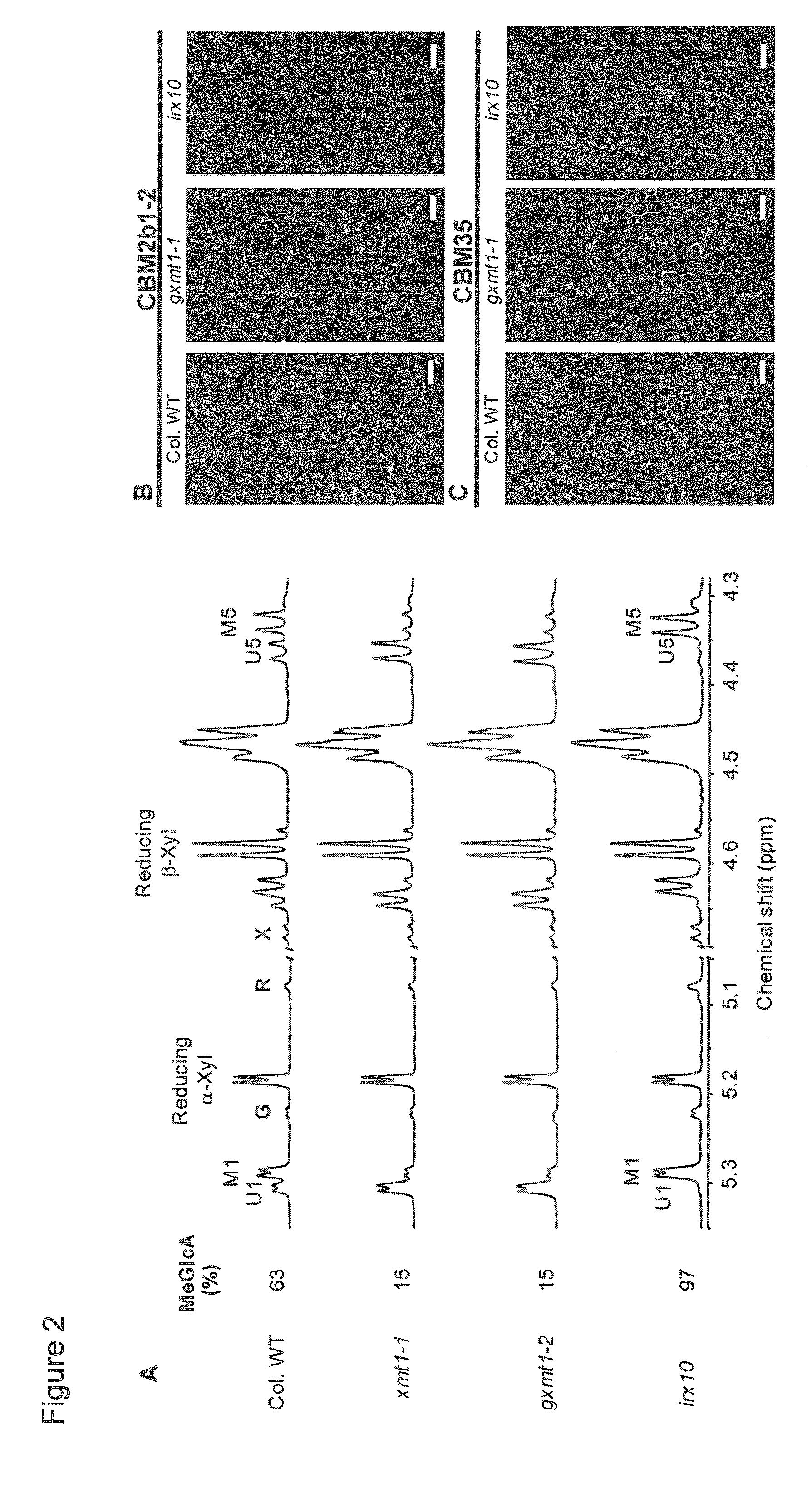Plants with altered glucuronoxylan methyl transferase activity and methods of use
a technology of methyl transferase activity and plant, applied in the field of plants with altered glucuronoxylan methyl transferase activity and methods of use, can solve the problem of increasing the cost of bioconversion to these products
- Summary
- Abstract
- Description
- Claims
- Application Information
AI Technical Summary
Benefits of technology
Problems solved by technology
Method used
Image
Examples
example 1
4-O-Methylation of Glucuronic Acid in Glucuronoxylan is Catalyzed by a DUF Family 579 Protein
[0125]4-O-methyl glucuronoxylan is one of the principle components present in the secondary cell walls of eudicotyledonous plants. However, the biochemical mechanisms leading to the formation of this hemicellulosic polysaccharide and the effects of modulating its structure on the physical properties of the cell wall are poorly understood. Described herein is the identification and functional characterization of an Arabidopsis glucuronoxylan methyltransferase (GXMT) that catalyzes 4-O-methylation of the glucuronic acid substituents of this polysaccharide. AtGXMT1, which was previously classified as a Domain of Unknown Function (DUF) 579 protein, specifically transfers the methyl group from S-adenosyl-L-methionine to O-4 of α-D-glucopyranosyluronic acid residues that are linked to O-2 of the xylan backbone. Biochemical characterization of the recombinant enzyme indicates that GXMT1 is localize...
example 2
Details of Materials and Methods Used in Example 1
[0147]Plant materials and mutant identification. All Arabidopsis thaliana plants used were in the Columbia (Col-0) background. Seeds of T-DNA insertion lines (SALK—018081, gxmt1-1; SALK—087114, gxmt1-2) in AtGXMT1 (At1g33800) were obtained from the Arabidopsis Biological Resource Center (available using the world wide web at arabidopsis.org). Arabidopsis irx10 seeds (Wu et al., 2009, Plant J 57:718-731) were a gift of Alan Marchant (University of Southampton, England). A. thaliana plants were grown in Conviron growth chambers under short-day conditions (12 h photoperiod) at 22° C., 50% relative humidity, and a light intensity of ˜180 μmol photons m−2 s−1.
[0148]PCR analysis of genomic DNA isolated from individual gxmt1-1 and 1-2 plants was used to confirm the presence of the T-DNA insertion and the absence of the intact gene. The following primers were used: SALK—018081_LP (5′-TGCAACTACCATGTTGGTTCC, SEQ ID NO:34), SALK—018081_RP (5′-A...
example 3
[0172]As described in Example 1, we have demonstrated that an Arabidopsis gene (At1g33800) encodes a cation-dependent glucuronoxylan methyltransferase (GXMT1) that specifically methylates O-4 of the GlcA substituents of GX. This OMT is a member of a family of proteins that contain a Domain of Unknown Function 579 (DUF579), which includes four phylogenetic clades. The Clade I in Arabidopsis contains AtGXMT1 and other two uncharacterized proteins that share high sequence similarity with GXMT1. To investigate if these two proteins are glucuronoxylan methyltransferases, we isolated and characterized two homozygous T-DNA insertion lines (SALK—050883, which we named gxmt2-1 and SALK—084669, which we named gxmt3-1) in which At1g09610 and At4g09990, respectively, are disrupted. RT-PCR analysis was used to confirm that the transcript was absent in these lines using primers to the full length coding sequence. The gxmt2-1 and gxmt3-1 plants were morphologically indistinguishable from wild type...
PUM
| Property | Measurement | Unit |
|---|---|---|
| Fraction | aaaaa | aaaaa |
Abstract
Description
Claims
Application Information
 Login to View More
Login to View More - R&D
- Intellectual Property
- Life Sciences
- Materials
- Tech Scout
- Unparalleled Data Quality
- Higher Quality Content
- 60% Fewer Hallucinations
Browse by: Latest US Patents, China's latest patents, Technical Efficacy Thesaurus, Application Domain, Technology Topic, Popular Technical Reports.
© 2025 PatSnap. All rights reserved.Legal|Privacy policy|Modern Slavery Act Transparency Statement|Sitemap|About US| Contact US: help@patsnap.com



